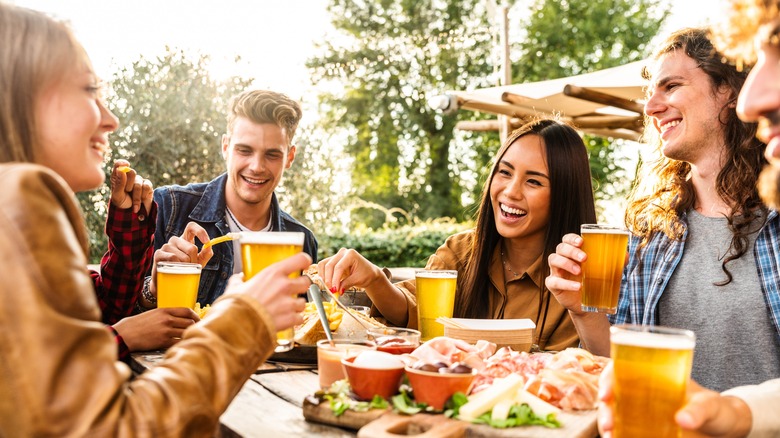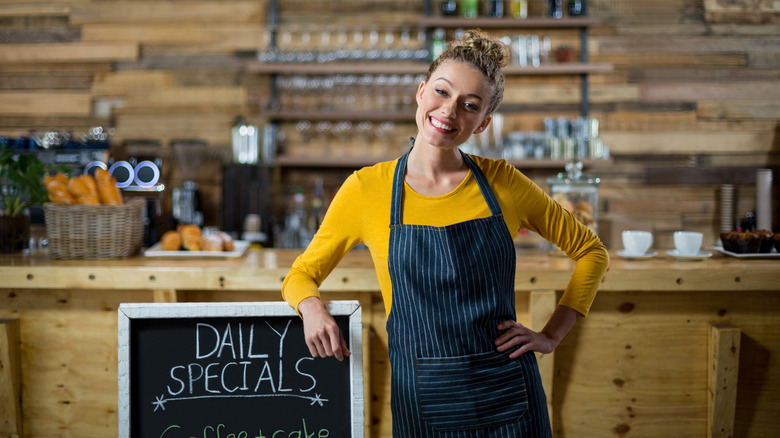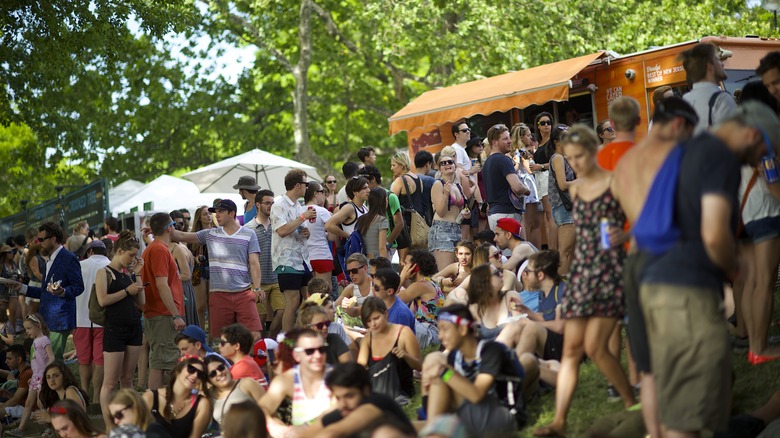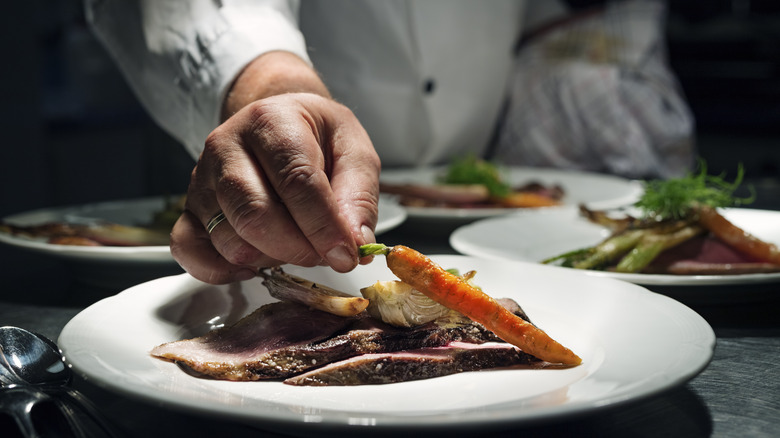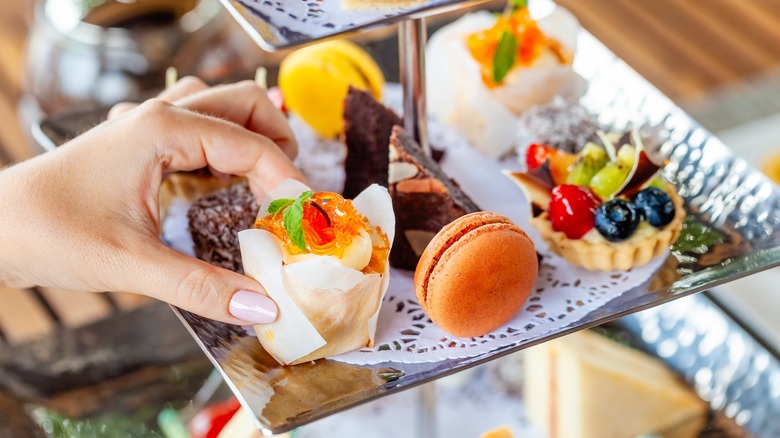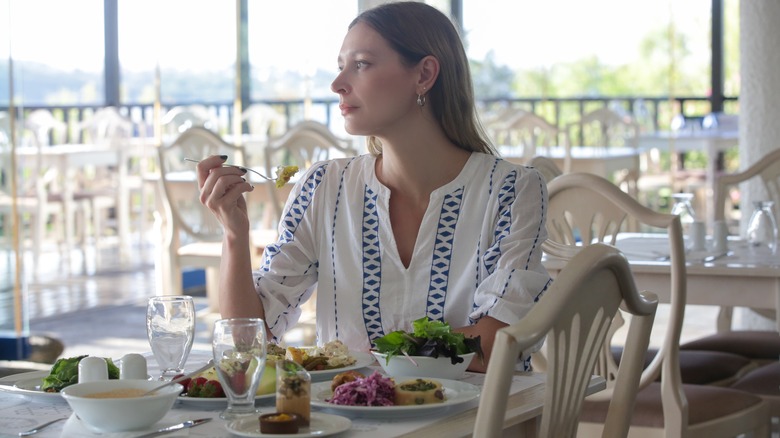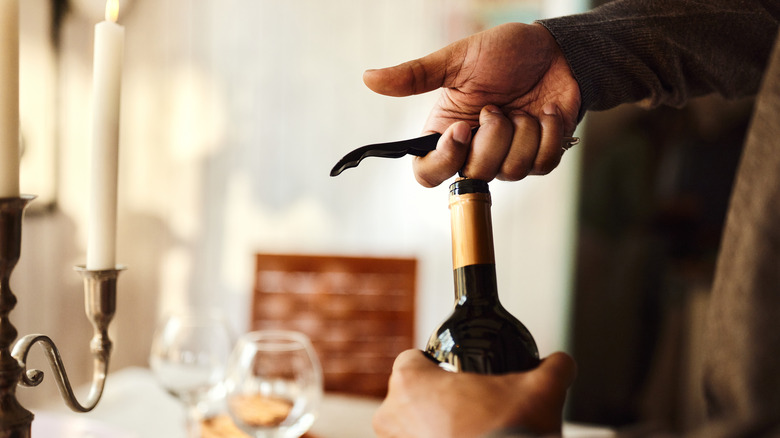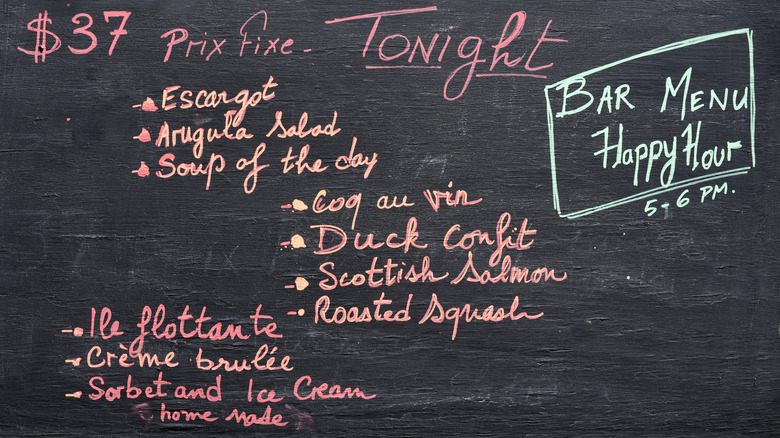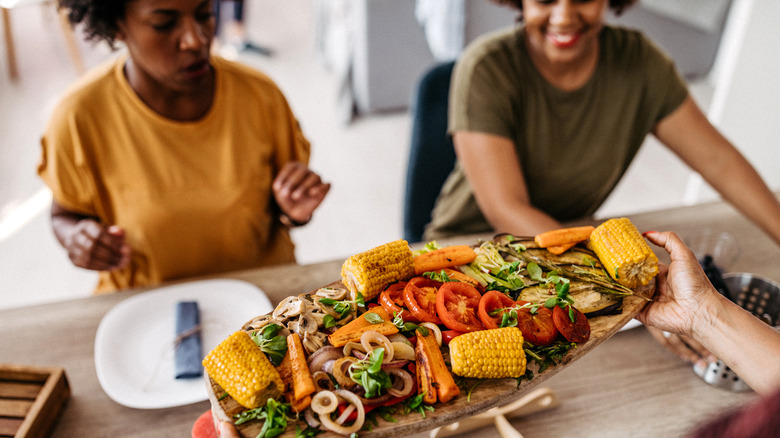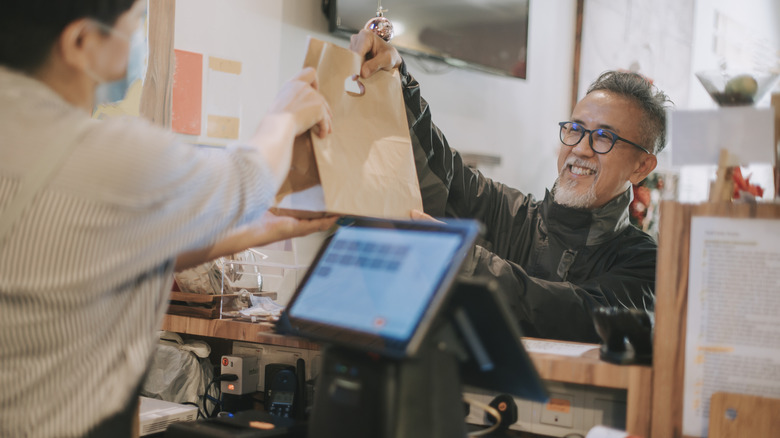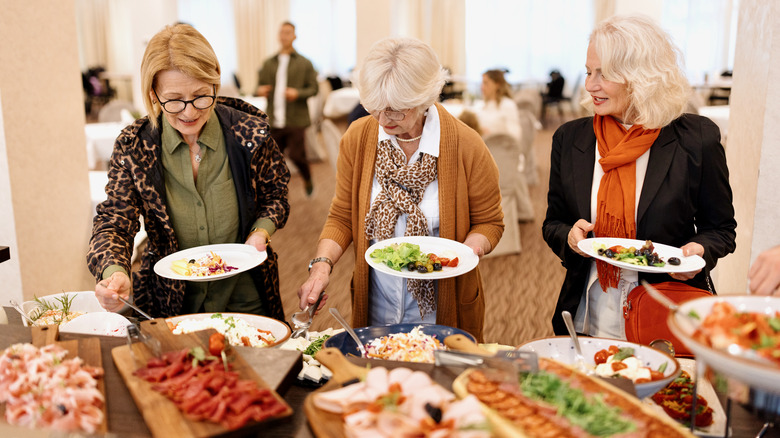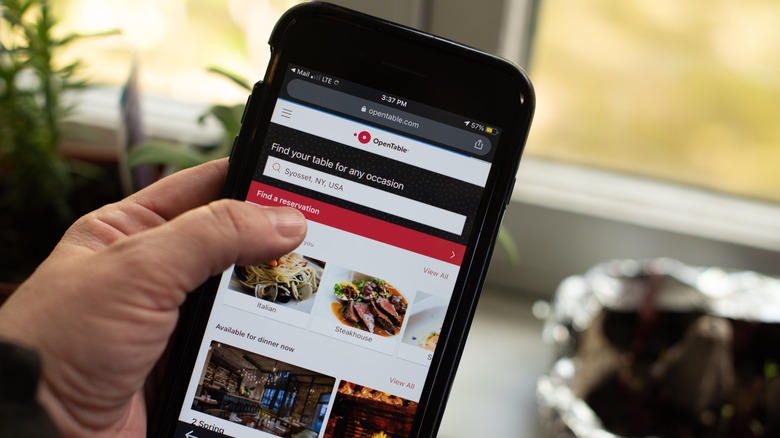14 Restaurant Tricks That Will Save You Money Every Time You Dine Out
The U.S. Bureau of Labor Statistics points to a 20.1% uptick in food spending related to "food away from home" that began post-COVID in 2022, breezing past 2019 spending levels. According to Axios, the U.S. consumer spent 20.7% more money on eating out than on groceries, a percentage that grew to 29.5% in the first quarter of 2023. That's roughly $130 for every $100 Americans spent on groceries, representing a reversal of trends in the last decade wherein 2013 grocery expenses took the lead.
Even before rising inflation, restaurants already levied a 300% upcharge on everything from food to beverages, with the need to cover equipment, upgrades, staffing, food, and utilities added to your bill. The notoriously low wages of staff tasked with surviving on an average of $14.71 per hour should also be supplemented by tips in the range of 15% to 20%. But don't cancel your restaurant reservations just yet. These tried and true tricks will keep more money in your pocket the next time you dine out.
Take advantage of happy hour deals
Happy hour usually guarantees diners on a budget a break in the form of drink and food specials. An $18 cocktail isn't out of the ordinary anymore, and the $20 cocktail is imminent. Take into consideration the average lowered price point of 20% for alcohol and 35% for meals. A regularly priced $18 margarita rounded down to $14 and a pound of chicken wings, regularly priced at $16 but reduced to $10, is a steal. If you ate out twice a week at this rate, that would be the equivalent of saving $20 a week, or $1,040 a year.
For bars and restaurants, happy hour acts as a draw at their least busy hours, usually 4 p.m. to 7 p.m. It gets people into the establishment early under the auspices of getting a deal and creates extra profit through your presence and the opportunity to upsell. Even more than food, cocktails are a winner for restaurants, and according to CGA by NielsenIQ, added upwards of $11,400 to an establishment's bottom line in the first quarter of 2023. For patrons, of whom some 47% suggest pairings of food and drinks are major incentives, the benefit goes directly into their bellies and wallets.
Stick with bottled water
Also related to happy hour is the topic of alcoholic beverages and how they can impact your bill. While 35% of men choose beer over cocktails and 39.5% of women order cocktails over beer, only 3% of anybody orders the least expensive drinks. You can't get much more of a deal on a restaurant beverage with an automatic 300% mark-up than water. Most restaurants in the U.S., unless under state regulations related to water conservation, offer water as a courtesy to their guests.
That said, a liter of bottled water (opt for water that doesn't come in plastic bottles, which are a major source of plastic pollution) is good for two people in one sitting and is much cheaper than, say, a bottle of vino at $60. One caveat, if you go for the water, is to consider using all the extra money you save by not ordering alcoholic beverages on a bottle of filtered H2O.
Take advantage of daily deals
In an attempt to get more diners in seats during slow periods of the day, many restaurants offer daily specials. Lunch and brunch specials are happy go-to opportunities for saving on a good meal. Sites like Livingonthecheap offer a national listing of chain restaurants complete with daily "buy one get one free" offers alongside discounted value menu specials. Aside from daily specials, certain days of the week also raise your odds of getting a break on your restaurant bill.
Mondays tend to be quiet, creating a laid-back vibe with more attentive service in addition to specials. According to Restaurant Business, many establishments are carrying their Monday specials into Tuesday, with most restaurants choosing Monday as a rest day for people in the industry. This leads the publication to question whether Tuesday is the new Monday. Ultimately, whatever day of the week offers the deepest discount on a great meal should be your day of the week to make a reservation.
Avoid food festivals
Food festivals can be fun outings where food lovers, connoisseurs, and trend chasers can get a taste of the best their city has to offer in one place. Whether they be food trucks or indoor popups, food festivals tend to be expensive. If you have a two-hour window to enjoy 100 food vendors, and the best vendors have 100 people in each line, you might be lucky to eat at two or three of your favorites before time runs out.
A $75 to $100 ticket, according to Southern Foodways Alliance, makes an event that used to be about celebrating a harvest into an overhyped, overpriced affair generating millions for big-name festivals partnered with huge brands. Aside from the cost, the effect on local food culture is also questionable since the vendors involved are often working for exposure and not making a significant fraction of the festival organizer's profits.
Stay away from fine dining
Having expensive tastes can be, well, expensive. Furthermore, fine dining stalwarts have often come under scrutiny as a shift in attitudes about the sort of unfair labor practices and toxic working conditions these establishments require to operate at such high levels while turning a profit — even at hundreds of dollars for a seat. This has many former fine-dining chefs downsizing to more casual fare.
Fast casual, a form of higher quality fast food served in a more casual environment, is on the rise due to factors like convenience, affordability, and sometimes health consciousness. According to the research firm Technavio, fast casual restaurants are estimated to grow annually by 10%, fueled largely by Millennials between the ages of 20 and 35 years of age who eat out at least once a week. This makes sense when you consider the specific financial challenges of that generational cohort causing 74% of Millennials to believe they've fallen behind previous generations financially under a $4 trillion debt while surviving check-to-check according to 73% of them. But you don't need to be a Millennial to be conscious of your spending habits, and avoiding fine dining is one easy way to control your restaurant bill.
Skip appetizers and desserts
Do you really need that gluten-free lava cake to cap off your dinner? What about a bowl of nachos before plowing into your steak frites? Unless you're hyperglycemic, the answer is, likely, no. The markup on restaurant food is priced into everything, including the meals around your mains.
Chicken tenders as a warm-up for the main meal may seem harmless at $10 a plate, but when you consider the restaurant made it for $3.50, you get an idea of how much unnecessary money you're spending on a pre-meal you could make at home for $1.65 per half dozen portion. Meanwhile, your dessert will be 300% higher than the cost of ingredients, with that aforementioned lava cake available at your local grocery store for a third of what you're paying for it. The margin between making a profit and what the restaurants know you are psychologically prepared to pay for is so thin that most establishments would prefer you order a cocktail over a pastry chef's concoction anyway. Order a substantial enough meal at a restaurant with fair portions and skip the extras.
Dine out all by your lonesome
According to a US.Foods survey, on average, individuals in the U.S. eat out at least three times a month or 36 times a year. When people who dine out were asked their top five reasons for doing so, the number one reason at 63% of respondents was the atmosphere. This matters since dining out with others, specifically on a date, can cost you more money whether covering another person's bill or unfairly splitting one in a group.
Solo reservations grew 80% in the four years between 2014 and 2018, with more people living solo in major urban centers with a bunch of options. The societal pressures of feeling lonesome have dissolved due to inflationary pressures, a relaxing of societal norms, and attention directed toward slow living and mindfulness. Simply, dining alone allows you to focus more on the ambiance and food, which in turn offers a better dining experience.
Bring a bottle of wine and pay a corkage fee
Wine sells for 300% to 400% of the actual cost, raising that $20 bottle of liquor store cabernet to $60 or $80 on your restaurant bill. Sometimes a restaurant will charge per glass whatever it costs to purchase the bottle, meaning that a $15 bottle of Pinot Grigio becomes a $15 five to 9-ounce glass on your table. If you're in the mood for something a little stronger than water, consider researching local restaurants that offer "bring your own bottle (BYOB)" as an option.
There's etiquette beyond just calling ahead to ensure the restaurant offers this service. For one thing, most restaurants require you to pay a corkage fee, which is out of respect for the work involved in the sommelier wine selection you're ignoring, and the server who has to serve your less expensive wine to you. The legitimacy of this argument becomes more questionable as the corkage fee rises. The San Francisco Chronicle mentions one restaurant in the Bay area that charges $50 in corkage fees, with other restaurants going as high as $100 to open and serve a bottle of wine you brought along — so be vigilant in your choice of restaurant.
Look for a prix fixe menus
Chefs are glomming onto prix fixe menus because they allow an outlet to express their versatility, while also helping them to better audit and control costs since a standard three-course meal is predictable and requires less service. With the issue of staffing in the restaurant industry and rising food costs, this is a win-win for restaurants.
The good news for diners is that a prix fixe is the rare instance in which what's good for a business is also good for the customer. The predictability around service and the more controlled cost of labor and food are passed along to diners in the form of more economical bills. The courses added onto these menus cost you 30% to 40% less than ordering a la carte. Most cities have some version of Restaurant Week, where restaurants attempt to entice you into their establishments with lowered prix fixe menus. The best way to get the most out of prix fixe menus is to compare the regular price of a restaurant's menu items with the prix fixe menu to ensure you're getting a deal and enjoy a pricier restaurant since you're getting the same food at a reduced price.
Go vegan or vegetarian for a night
According to the University of Oxford, vegan and vegetarian diets in countries like the U.S. can reduce your general food costs by a third. In a study carried out by The Beet, on average, diners saved $23 on their grocery bills in comparison to carnivores, and you can imagine those savings are also experienced by restaurants, which then pass those savings onto your restaurant bill. With meat and seafood being pushed up 40% due to inflation, switching out steak for tempeh is an economical way of eating out. Nowadays, only 67% of mains served in major restaurant chains include meat.
The better news is that vegan and vegetarian diets have progressed well beyond tofu and bean sprouts. Better still, a lot of foreign cultural cuisines, like Indian or Asian, have mastered the art of meatless dishes and are often mom-and-pop restaurants that are already more affordably priced. It should be noted that part of why we've come to expect ethnic restaurants to be cheaper has as much to do with racism and pay inequity as food costs. Still, going vegetarian or vegan can result in a lower service bill and a full belly.
Avoid delivery apps
If you've ever asked yourself whether food ordering and delivery apps like DoorDash save you money, consider the cost of food delivery. Americans on average spend $1,850 per year on delivery, and worse, premium subscribers tend to use the apps twice as much as casual app users. The hidden costs of delivery, including service fees and tips on top of the delivery fee can add up to 36% to your delivery charge. Even ordering something as small as a coffee can trigger a small order fee, which adds a few dollars to your cup of morning java.
Pre-ordering using apps isn't much better, and staying local and not being lazy can save you an average of over $50 per month in delivery fees, which is money you can put into savings or investing in stocks. Forgo delivery apps — it will help support your near-to-home restaurants as well as your personal finances.
Seek out lunch specials
Restaurants price lunch cheaper than dinner based on factors like less experienced staff working lunches versus dinners, smaller menus with smaller portions, quicker seating turnarounds allowing for more business, and fewer add-ons like candles, expensive wines, and additional staff keeping the lunch rush less expensive. Again, higher or lower costs are always passed on to the diner, so taking advantage of local lunch specials are a great way to save on dining out.
Appetizers like soup or salad are typically $4 to $5 cheaper than mains at any time of the day, and the lighter portions make sense since carb crashing is not something you want in the middle of your workday. Looking at the difference between some chain restaurants' dinner and lunch menus, like Applebee's for instance, you'll find some dinner mains twice as much as lunch items, while Red Lobster offers dinner items that are up to three times as much as items on the lunch menu.
Eat your money's worth at a buffet
Lunch buffets offer a chance to go the other way on a day off, especially when you're really hungry and don't have much planned for the day. Buffet chains amassed $5.5 billion in 2022, with restaurants like Golden Corral's sales over the last three years increasing by 14%. According to theHustle, an average $20 buffet breaks down into 37% for the food, 30% in staffing, 14% in rent, 14% in amenities, and 5% in profit. The way restaurants make money on this model has to do with more seatings based on less waiting time for food. They also employ tricks like setting out smaller plates of cheaper food to keep costs down.
At an average of $7.40 per buffet meal per person, you would have to eat about three full plates of food to get your money's worth. However, fortunately for buffet chains, most people don't do that.
Make reservations with OpenTable for dining rewards
While you should avoid delivery and takeout apps if you want to save money on restaurant food, consider using reservation apps like OpenTable for their dining rewards. OpenTable has reservation options for 20,000 plus restaurants in the U.S., and each time you book a reservation through OpenTable, you earn reward points you can cash in for perks. For instance, if you earned 5,000 points and redeemed them for a meal, you could offset a dining bill by as much as $60. That's a free dinner at most reasonably priced restaurants.
You can also redeem the points for hotel stays through OpenTable's partnership with Kayak, which can lower the cost of your hotel booking by as much as $200. With over 400,000 participating hotels, you'll be able to use those points, too. To earn 2000 points, the first level of rewards you can redeem, you would have to book 20 reservations. With the average American eating out 36 times a year, to get to the highest reward bracket of 20,000 points, it would take 200 reservations or about six years to cash out $100 to $210 in dining rewards. Whether it's worth it is up for debate, but if you're going to be reserving seats at a restaurant anyway, you might as well get some added benefit out of it.

